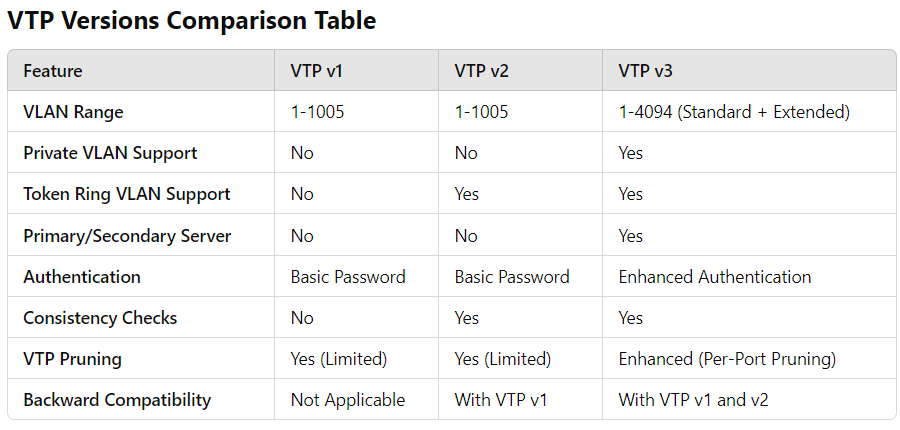VLAN Trunking Protocol (VTP): v1 vs v2 vs v3
VTP (VLAN Trunking Protocol) is a Cisco-proprietary protocol used to manage VLAN configuration across multiple switches within a network. It simplifies VLAN administration by allowing a switch designated as a VTP server to propagate VLAN information to other switches in the network. VTP has three major versions—VTP v1, v2, and v3—each with distinct features and enhancements.
VTP Version 1 (VTP v1)
Key Features:
- Basic VLAN Management: VTP v1 is designed to propagate standard VLAN information such as VLAN ID, name, and type (Ethernet, Token Ring) within the network.
- Domain Name: All switches must belong to the same VTP domain for VLANs to be propagated.
- Configuration Revision: VTP uses a configuration revision number to determine which VLAN database is more recent. The switch with the highest revision number becomes the authoritative source.
- VTP Modes: Switches can be set in three modes: Server (can create, modify, and delete VLANs), Client (cannot modify VLANs), and Transparent (passes VLAN information without participating in the VTP process).
Limitations:
- Limited VLAN Range: VTP v1 only supports standard VLAN ranges (VLAN IDs 1-1005).
- No Support for Extended VLANs: Extended-range VLANs (1006-4094) are not propagated in VTP v1.
- Prone to Misconfigurations: If a switch with an outdated revision number is introduced to the network, it can cause VLAN inconsistencies.
VTP Version 2 (VTP v2)
VTP v2 was introduced to overcome some of the limitations of v1.
Key Enhancements:
- Token Ring Support: VTP v2 adds support for Token Ring VLANs.
- Consistency Checks: It performs checks for consistency in VLAN information across the network (e.g., checking VLAN names and types). If discrepancies are detected, VTP v2 prevents propagation of inconsistent information.
- Unnecessary Information: VTP v2 can send more detailed information for certain kinds of VLANs, even if they are not being used (such as Token Ring), which can waste resources.
Limitations:
- Same VLAN Range as v1: VTP v2 still only supports VLAN IDs in the range of 1-1005. Extended VLANs are not propagated.
- Backward Compatibility: VTP v2 is backward compatible with VTP v1, meaning a VTP v2 switch can coexist with VTP v1 switches in the same network.
VTP Version 3 (VTP v3)
VTP v3 introduces several major improvements over its predecessors, making it much more flexible and secure.
Key Enhancements:
- Support for Extended VLANs: VTP v3 supports the propagation of extended VLANs (1006-4094), which is critical in larger and more complex networks.
- Primary and Secondary Servers: In VTP v3, there is a concept of a Primary Server, which is the only server allowed to make changes to the VLAN database. This helps prevent accidental overwrites of the VLAN database.
- Improved Security: VTP v3 supports enhanced authentication mechanisms to ensure only authorized changes to the VLAN database are allowed. This prevents unauthorized devices from corrupting the VLAN database.
- Private VLANs: VTP v3 can propagate information for Private VLANs, which are used for securing communication between hosts within a VLAN.
- Per-port VTP Pruning: VTP v3 has an enhanced VTP pruning mechanism that optimizes bandwidth by restricting VLAN traffic to only the trunks where the VLAN is needed.
Key Features:
- Extended VLAN Support: One of the biggest advantages of VTP v3 is that it supports both the standard VLAN range (1-1005) and the extended VLAN range (1006-4094).
- More Control: VTP v3 gives network administrators more control over VLAN management with the introduction of the primary and secondary server roles.
- Private VLANs Support: VTP v3 allows the propagation of private VLAN information, which is not possible in v1 or v2.
- Backward Compatibility: While VTP v3 is backward compatible with VTP v2, when used together, the features of v3 may be limited to those supported by v2.
VTP Versions Comparison Table

Key Takeaways:
- VTP v1: Basic VLAN management, suitable for smaller networks where extended VLANs are not needed.
- VTP v2: Adds Token Ring support and improved consistency checks but still limited to standard VLAN ranges.
- VTP v3: Introduces extended VLAN support, private VLANs, better security, and role-based management, making it ideal for modern, larger, and more secure networks.
For larger, more complex, and security-focused environments, VTP v3 is recommended because of its added flexibility, control, and features.